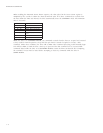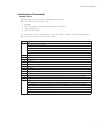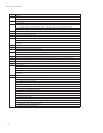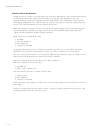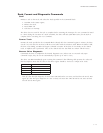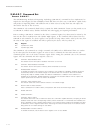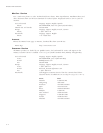
GLOSSARY
GL – 4
LOGICAL ADDRESS
A storage location address that may not relate directly to a physical location. Usually
used to request information from a controller, which performs a logical to physical
address conversion, and in turn, retrieves the data from a physical location in the mass
storage peripheral.
LOGICAL BLOCK ADDRESSING
Defines the addressing of the device by the linear mapping of sectors.
LOGICAL SECTOR
The lowest unit of space that DOS can access through a device driver; one or more
physical sectors.
LOW FREQUENCY
The lowest recording frequency used in a particular magnetic recording device. With
FM or MFM channel codes, this frequency is also called “IF.”
M
MAIN MEMORY
Random-access memory (RAM) used by the central processing unit (CPU) for storing
program instructions and data currently being processed by those instructions. (See also
random access memory.)
MASS STORAGE
Auxiliary memory used in conjunctions with main memory; generally having a large,
on-line storage capacity.
MEGABYTE (MB)
A unit of measure approximately one million bytes (actually 1,048,576 bytes) or 10
6
.
MEMORY
Any device or storage system capable of storing and retrieving information. (See also
storage definitions.)
MICROCOMPUTER
A computer whose central processing unit is a microprocessor. It is usually, but not
necessarily, desktop size.
MICROPROCESSOR
A central processing unit (CPU) manufactured as a chip or a small number of chips.
MISSING PULSE
A term used in surface certification. It is when a prerecorded signal is reduced in
amplitude by a certain specified percentage.
MODIFIED FREQUENCY MODULATION (MFM)
A method of encoding digital data signals for recording on magnetic media. Also called
“three frequency recording.” Recording code that only uses synchronizing clock pulse
if data bits are not present. Doubles the lineal bit density without increasing the lineal
flux reversal density, compared to Frequency Modulation.
MODIFIED MODIFIED FREQUENCY MODULATION
(MMFM)
A recording code similar to MFM that has a longer run length limited distance.
MODULATION
1. Readback voltage fluctuation usually related to the rotational period of a disk. 2. A
recording code, such as FM, MFM, or RLL, to translate between flux reversals and bits
or bytes.
N
NON-RETURN TO ZERO
A form of data encoding that is not self-clocking, in other words, it needs to be
provided with an external bit cell clock signal. Generally used in higher-performance
disk drives.
O
OFF-LINE
processing or peripheral operations performed while disconnected from the system
CPU via the system bus.
ON-LINE
processing or peripheral operations performed while disconnected from the system
CPU via the system bus.
OPEN LOOP SERVO
A head positioning system that does not use positional information to verify and correct
the radial location of the head relative to the track. This is usually achieved by use of a
stepper motor which has predetermined stopping point that corresponds to track
locations.
OPERATING SYSTEM
A software program that organizes the actions of the parts of the computer and its
peripheral devices. (See disk operating system.)
OUTSIDE DIAMETER
The largest radius recording track on a disk.
OVERWRITE
A test that measures the residual 1F recorded frequency on a track after being
overwritten by a 2F signal. Variations of the test exist.
P
PARALLELISM
1. The condition of two planes or lines being parallel. Important in disk drives because
a lack of it in mechanical assemblies can result in positioning inaccuracy. More
precisely: planes-coplanar; lines-colinear. 2. Is the local variation in disk thickness
measured independently of thickness itself. 3. The ability of a multiprocessor computer
to allocate more than one processor (CPU) to a computing problem, where each CPU
works on a separate problem or separate segment of that problem. Also referred to as
parallel processing.
PARITY
A simple method of data error detections that always makes numbers either odd or
even, using an extra bit in which the total number of binary 1s (or 0s) in a byte is
always odd or always even; thus, in an odd parity scheme, every byte has eight bits of
data and one parity bit. If using odd parity and the number of 1 bits comprising the
byte of data is not odd, the ninth or parity bit is set to 1 to create the odd parity. In this
way, a byte of data can be checked for accurate transmission by simply counting the
bits for an odd parity indication. If the count is ever even, an error is indicated.
PARTITION
A logical section of a disk drive, each of which becomes a logical device with a drive
letter.
PEAK SHIFT
The shifting in time of the zero-slope portion of a readback voltage from the values
contained in the write current waveform. Sometimes incorrectly used to describe bit
jitter.
PERIPHERAL EQUIPMENT
Auxiliary memory, displays, printers, and other equipment usually attached to a
computer system’s CPU by controllers and cables. (They are often packaged together in
a desktop computer.)
PHASE LOCKED LOOP (PLL)
A circuit whose output locks onto and tracks the frequency of an input signal.
Sometimes incorrectly called a data separator.
PHASE MARGIN
Measure in degrees of the amount of difference between excursions from the window
center where flux reversals can occur and the edge of the data window. Similar to
window margin.
PHYSICAL SECTOR
The smallest grouping of data on the hard disk; always 512 bytes.
PIO
Programmable Input Output. A means of accessing device registers. Also describes one
form of data transfers. PIO data transfers are performed by the host processor using
PIO register accesses to the data register.
PLATED THIN FILM MEDIA
Magnetic disk memory media having its surface plated with a thin coating of a metallic
alloy instead of being coated with oxide.
PROCESSING
The process of the computer handling, manipulating and modifying data such as
arithmetic calculation, file lookup and updating, and word pressing.
PULSE CROWDING
Modification of playback amplitude due to super-positioning of adjacent flux reversal
fields being sensed by the read/write gap.
PULSE DETECT
A digital pulse train in which each leading edge or each edge corresponds to a
magnetic transition read from the disk. If transition qualification circuitry exists in the
drive, this signal is the output of same. Also known as transition detect.



